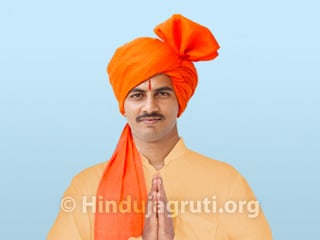1. Introduction
Hindu culture is enriched with Chaitanya (Divine consciousness). After studying various attires at the gross as well as the subtle levels, that is, by taking into consideration the spiritual perspective, Hindu Dharma has given importance to certain attires In this article, let us understand the importance of wearing a turban and its benefits.
2. Why did the custom of wearing a turban originate ?
In Kaliyug, human beings have begun to drift away from God and Dharma. Hence, the need was felt to create bhāv (Spiritual emotion) towards the karma (Action which gives rise to destiny) performed, and make them solemn about the karma for generating yearning towards God-realisation at least by using external means such as turban. It is out of this need that the custom of wearing a turban originated.
3. Importance of the turban and its benefits
3A. Method of wearing a turban helps in accumulation of sāttvik waves in the body
Easiest, simple and sāttvik method is to wrap a panchā (Towel) or washed cloth in a rounded manner around the head. Sāttvik vibrations of the universe congregate in the void created in the middle of the turban. This arrangement of the turban helps in augmentation of sāttvik vibrations within the body.
3B. The contact of the turban helps in development of pure intellect
The pattern on the head created by the way the turban is tied is extremely sāttvik. This is because the vibrations that congregate in the turban’s round shape are associated with dnyān-shaktī (Energy of knowledge) and hence, contact with the turban helps in the development of pure intellect in the individual. Multiple folds in the turban increase the proportion of congregation of vibrations of dnyān-shaktī. Since mārak (Destroyer) as well as tārak (Saviour) waves congregates in the turban as per the need, the individual benefits according to its constitution.
3C. The turban increases the presence of kārya-shaktī (Energy of action) in the body
When the presence of the kārya-shaktī in the body is to be increased, one end of the turban is left hanging at the back. The contact of the turban cloth with the vertebrae helps in keeping the sushumnā-nādī (The central channel of the spiritual energy flow system, which extends from the base of the spine to the top of the head) in an awakened state.
3D. Subtle-waves of Divine Principle are imbibed by the turban, due to which the individual’s sthūldēha (Gross body), manodēha (Mental body), kāraṇdēha (Causal body) and mahākāraṇdēha (Supracausal body) are purified
The subtlest waves of the superior Deities present in the universe are attracted towards the turban, and through the Sahasrār-chakra (Notional opening situated at the crown of the head, which leads to realisation of Brahman and Shiv) of the individual, they spread all over the body of the individual and get activated. Similarly, because of the turban, subtle-waves of Principles of Deities that are sāttvik and Chaitanya-bestowing are imbibed. This leads to purification of the individuals’s sthūldēha (Gross body), manodēha (Mental body), kāraṇdēha (Causal body) and mahākāraṇdēha (Supracausal body) are purified; then, they become sāttvik and are enriched with Chaitanya. This in turn reduces the individual’s ego. Such a individual performs virtuous tasks effortlessly, and if the individual’s bhāv is above 30%, Deities function through it.
3E. A reddish orange sheath, which contains kshātra-shaktī (Energy of a warrior) and dnyan-shaktī, is created around the individual that wears a turban
A reddish orange sheath is created around the individual that wears a turban. This sheath contains kshātra-shaktī (Energy of a warrior) and dnyān-shaktī. The turban acts like a crown on the head. A protective sheath is created around the head because of the turban. Therefore, the individual does not imbibe negative vibrations from the environment. The turban reduces the extent of distressing covering around individual’s intellect, and creates a bhāv of renunciation in the individual.
3F. Emission of red waves from the turban and blue and orange waves from the lower round portion of the turban, which is beneficial for the individual who wears it and also to others around him.
-
Red colour waves emitted by the turban flow into the individual’s Anāhat-chakra (The fourth centre in the spiritual energy flow system, located in the region of the heart in the subtle-body) and keep its kshātrabhāv (Spiritual emotion of a warrior) awakened. Since these waves spread into the environment, a red colour energised sheath is created around the individuals that come into direct contact with these waves and others close by.
-
Blue and orange colour waves are emitted into the environment from the turban’s lower round portion. Blue colour waves of bhāv help in inculcating virtues of modesty and humility in the individual that wears the turban. Similarly, since these waves spread in the environment, those who imbibe them get similar benefits.
-
The loose end of the turban hanging at the middle of the back of the individual is enriched with bhāv, Shaktī and nirguṇ (Non-materialised) waves and hence, their combined energy forms a coil around the individual and remains there. Therefore, the individual gets a continuous supply of energy.
4. Colours of the turban according to the objective
4A. Red colour for Kshātratēj (Radiance of a Kshatriya [warrior]): For emission of waves of Kshātratēj the turban should be red. Red colour is also conducive to protection against attacks from negative energies.
4B. Yellow colour for Brāhmatēj (Radiance of a Brāhmaṇ [One who belongs to the first of the four classes, studies scriptures and imparts knowledge to the society]): To spread Brahmatej in the society and to imbibe within self, the turban should be yellow in colour. Yellow colour is conducive for spiritual progress.
5. Using the turban as per the spiritual level
-
Individuals below 50% spiritual level : Use of red turban is beneficial.
-
Individuals above 50% spiritual level : Use of yellow turban is beneficial.
-
Individuals above 60% spiritual level : The attire does not have much importance for these individuals, since they have been liberated from Māyā (Great Illusion).
6. Turban and mundāsē (A small type of Turban)
In the earlier times, mundāsē (A white piece of cotton cloth) used to be wrapped around the head. This arrangement is excellent from the perspective of imbibing sāttvik waves, while the method of tying the turban with a plume at the top of the turban and the loose end hanging at the back is excellent for emitting positive waves from the folds of the turban. A turban has greater ability to emit positive waves, while wrapping a mundāsē around the head is good for imbibing positive waves.
Reference: Sanatan Sanstha’s Holy Text ‘Spiritually beneficial clothes for men’



